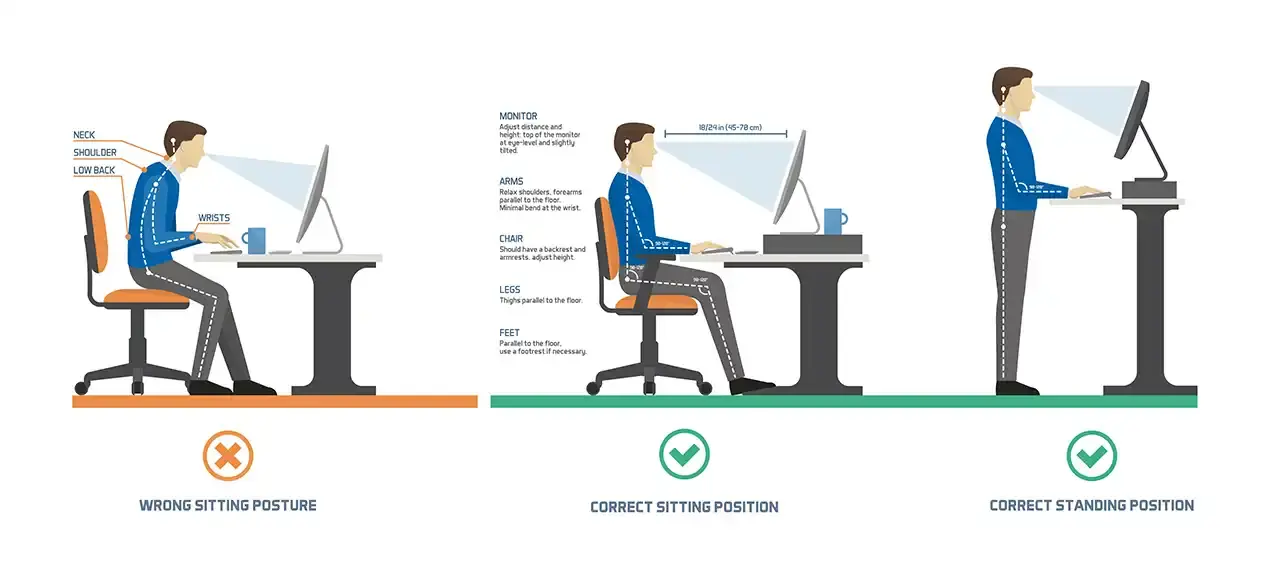
How to Improve Your Posture at Work (Easy Tips for Better Alignment).
Do you often end your workday with a stiff neck, sore shoulders, or lower back pain? Poor posture at your desk could be the culprit. Slouching, hunching over your keyboard, or craning your neck forward can lead to long-term muscle strain, headaches, and even reduced energy levels.
The good news? You can fix your posture with simple adjustments. This guide will show you how to sit correctly, set up your workspace, and strengthen your body to stay pain-free.
Why Good Posture Matters at Work
Good posture isn’t just about looking confident—it helps your body function properly. Benefits include:
✔ Less pain (neck, shoulders, back)
✔ Better breathing (slouching compresses lungs)
✔ More energy (poor posture causes fatigue)
✔ Improved focus (proper alignment = better circulation)
✔ Prevents long-term damage (reduces spinal stress)
5 Easy Ways to Fix Your Posture at Work
1. Set Up Your Desk Correctly
- Monitor Height: The top of your screen should be at eye level (use a stand or books if needed).
- Keyboard & Mouse: Keep them close so your elbows stay at a 90-degree angle.
- Chair Position: Sit back fully—your lower back should touch the chair’s support.
2. Sit (or stand) the Right Way
- Feet Flat: Keep them on the floor (or a footrest if needed).
- Hips Slightly Higher Than Knees (adjust chair height).
- Shoulders Relaxed (not hunched up toward ears).
- Head Aligned (ears over shoulders, not jutting forward).
Bonus: Try a standing desk for part of the day to avoid sitting too long.
3. Take Micro-Breaks Every 30 Minutes
- Stand up, stretch, or walk for 1-2 minutes.
- Set a timer or use an app (like Stand Up!) to remind you.
4. Do Quick Posture Exercises
- Chin Tucks (fix "tech neck"): Gently pull your head back like you’re making a double chin. Hold for 5 seconds.
- Shoulder Blade Squeeze: Pull shoulders back and down, squeezing your shoulder blades together. Hold for 10 seconds.
- Seated Twist: Sit tall, twist gently to one side, hold for 15 seconds, then switch.
5. Strengthen Your Core & Back
Weak muscles make good posture harder. Try these daily:
- Planks (start with 20 seconds)
- Wall Angels (stand against a wall, slide arms up and down)
- Cat-Cow Stretch (on hands and knees, arch and round your back)
Common Posture Mistakes (And How to Fix Them)
❌ Leaning Forward (Desk Slouch) → Sit back, use a lumbar pillow.
❌ Crossing Legs → Keep feet flat to avoid hip imbalance.
❌ Cradling Phone Between Ear & Shoulder → Use headphones or speakerphone.
❌ Looking Down at Laptop → Raise it to eye level with a stand.
Long-Term Tips for Better Posture
- Use ergonomic tools (adjustable chair, footrest, or standing desk).
- Exercise regularly (yoga and swimming strengthen posture muscles).
- Sleep on a supportive pillow (side sleepers need a thicker one).
- Stay hydrated (dehydration makes muscles stiff).
Final Thought: Be Patient!
Improving posture takes time—your body is used to old habits. But with small, consistent changes, you’ll feel less pain and more energy in just a few weeks.
Try one tip today (like adjusting your monitor height) and build from there. Your back will thank you!
Leave a comment
Your email address will not be published. Required fields are marked *


